Des Moines Water Utility to File Nitrate Pollution Lawsuit
Farming practices are adding harmful nitrates to Iowa’s Raccoon River. The capital city’s water utility will vote at a March 10 board meeting to proceed with a Clean Water Act lawsuit.
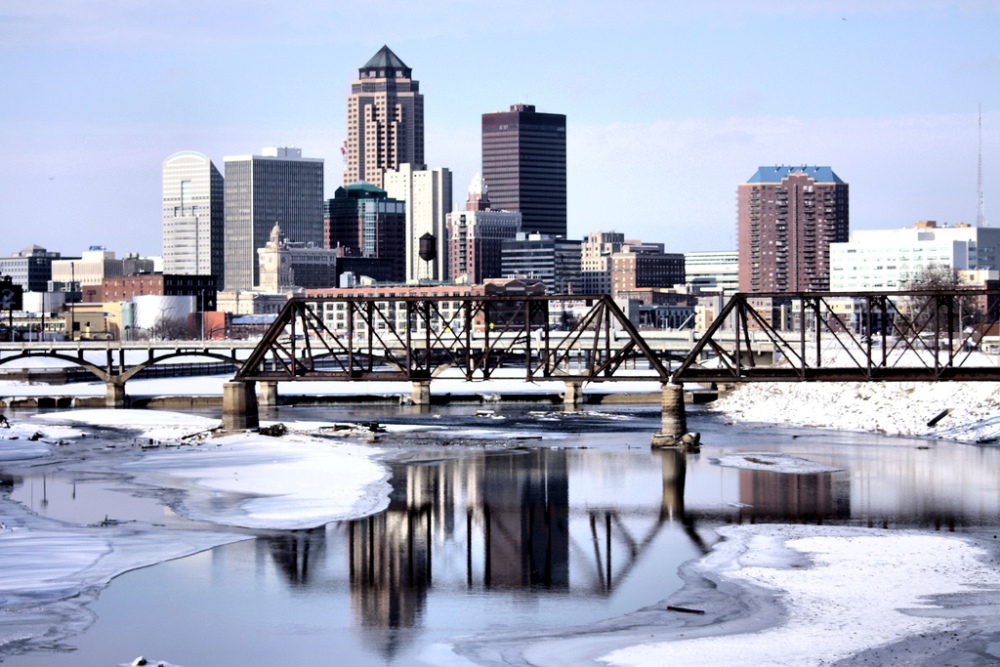
By Brett Walton
Circle of Blue
A lawsuit with far-reaching implications for agriculture, water pollution, and farming practices in the Midwestern Corn Belt of the United States appears headed to federal court.
On March 10, the Des Moines Water Works board will vote to proceed with a Clean Water Act lawsuit over nitrate pollution in the Raccoon River, a source of drinking water for 500,000 people in Iowa’s capital city. The lawsuit claims that local agencies that drain water from beneath farmland and add nitrates to waterways should go through the same federal pollution-permitting process as industrial facilities.
–Graham Gillette, chairman
Des Moines Water Works board
A problem in farm regions across the United States, nitrates — which come from septic systems, untreated sewage, nitrogen-based fertilizers, and the soil itself — feed the annual Delaware-sized dead zones in the Gulf of Mexico, generate toxic algal blooms in Lake Erie, and cause life-threatening blood disorders in infants and the elderly.
Graham Gillette, chairman of the five-member board, told Circle of Blue that he expects unanimous approval of the lawsuit, which has touched a nerve in Iowa, where farming is a cultural hallmark, an economic engine, and a political force.
Gillette is certain of a landslide vote, because discussions with local and state officials over the last two months did not produce any meaningful change in state policy. According to Gillette, the board met with the Department of Natural Resources, the Department of Agriculture, the attorney general, and the staff of Governor Terry Branstad (R), who was elected in November for a sixth term.
“As I sit here on a Friday, I can tell you that those meetings had no substance,” Gillette said. “We feel we have no other option than to seek remedy in court.”
Talks Go Nowhere
The water works board gave notice on January 9 that it intended to sue drainage districts in Buena Vista, Calhoun, and Sac counties, all upstream of Des Moines. Drainage districts manage a network of subsurface pipes that channel groundwater away from farm fields so that soggy land can be cultivated. Drainage districts are common in Illinois, Indiana, Iowa, Ohio, and southern Minnesota.
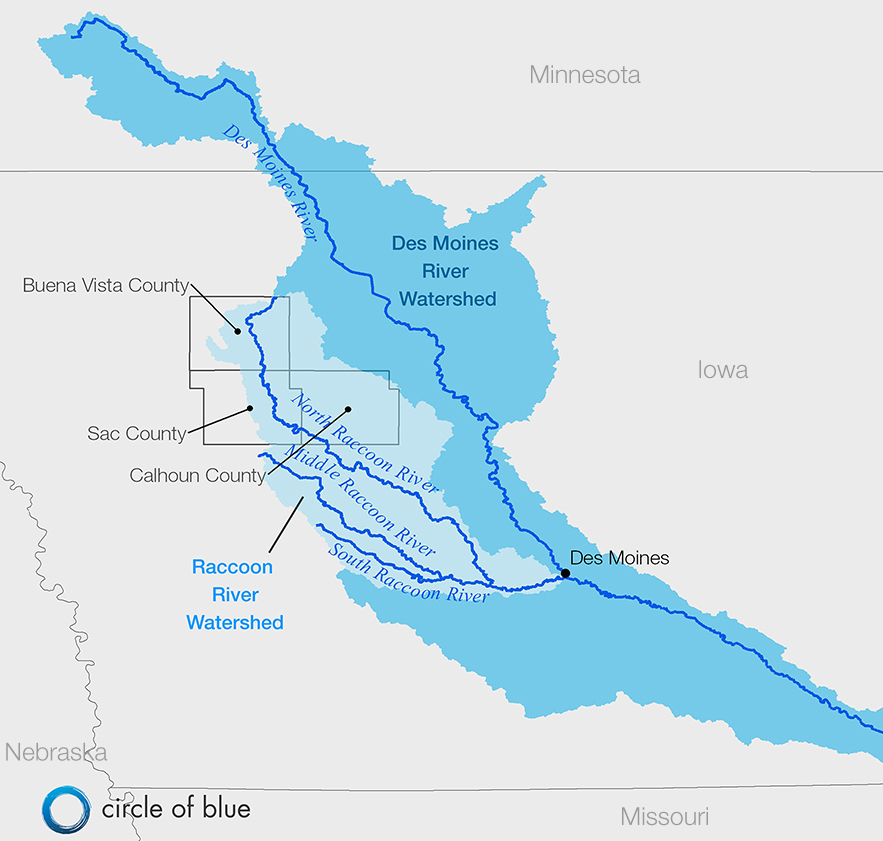
Filing the notice initiated a 60-day consultation period during which the parties could discuss solutions that would keep the matter out of court.
The notice generated significant attention. Governor Branstad called the board’s action “a war on rural Iowa,” while 63 percent of state residents said they supported the lawsuit, according to a Des Moines Register poll. Even among rural residents, 44 percent agreed with the utility’s action, while 42 percent opposed the legal maneuver.
Earlier this month, the Iowa Department of Agriculture provided $US 1.4 million in state funding for three projects to reduce water pollution from farming and requested applications for an additional round of funding to be awarded by the end of April. Over the last two years, the state has approved $US 50 million for projects to stem pollution from farms and to improve the state’s water quality. The grants were catalyzed by the state’s plan, published in 2013, to reduce nitrogen and phosphorus in waterways by 45 percent. (The plan does not have a timetable and relies on voluntary measures for agriculture.)
Despite these actions, Gillette said that the governor brushed off Des Moines’s request for more consistent monitoring and testing of water quality that would identify nitrate “hotspots.”
“There was a lack of acknowledgement of the serious situation,” Gillette said of the governor’s response. “He did not acknowledge that our issues are even serious enough to have a conversation.”
The governor’s office did not return phone and email messages asking for comment.
Getting Worse, Not Better
Though Iowa is one of two Mississippi River Basin states to approve a plan for reducing nutrient pollution, Gillette sees evidence that the nitrate problem around Des Moines is getting worse, not better.
Nitrate levels are particularly high this winter, which has forced the utility to operate its nitrate-removal facility continuously since mid-December at a cost of $US 500,000. The three months of nitrate levels above drinking water standards are an unprecedented stretch during the cold season when levels are usually lower. Federal law requires utilities to deliver drinking water with nitrates lower than 10 parts per billion.
Most farming activities were exempted from the 1972 Clean Water Act’s pollution permitting process. Gillette said that the board wants the courts to set pollution standards for drainage districts. Then farmers and local governments can figure out the best way to achieve the targets, whether by planting cover crops that soak up excess nitrogen, by changing fertilizer practices, or by some other method.
“I will do my best to continue these conversations, even as the lawsuit moves forward,” Gillette said. “The only way to solve this is to work together.”
Brett writes about agriculture, energy, infrastructure, and the politics and economics of water in the United States. He also writes the Federal Water Tap, Circle of Blue’s weekly digest of U.S. government water news. He is the winner of two Society of Environmental Journalists reporting awards, one of the top honors in American environmental journalism: first place for explanatory reporting for a series on septic system pollution in the United States(2016) and third place for beat reporting in a small market (2014). He received the Sierra Club’s Distinguished Service Award in 2018. Brett lives in Seattle, where he hikes the mountains and bakes pies. Contact Brett Walton



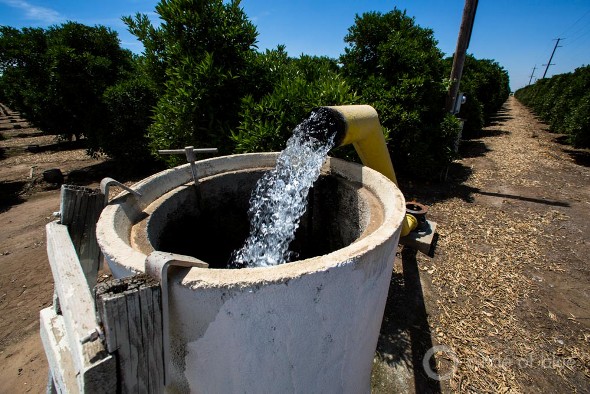
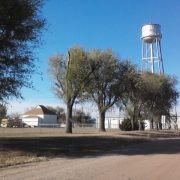
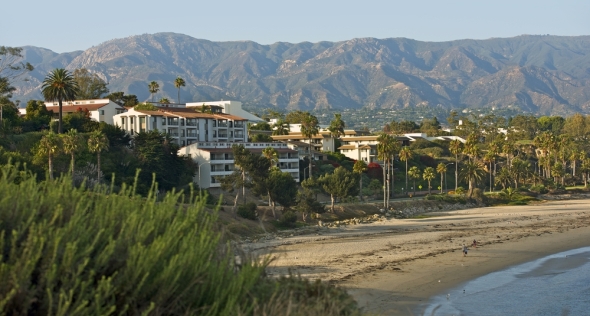
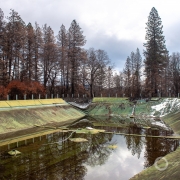

One problem with this lawsuit which I can easily foresee happening would be the unintended consequence of delaying the EPA in implementing it’s latest updates to the CWA (clean water act).
There are several sources of nitrates. One of them the fact that EPA never implemented the Clean Water Act (CWA) and does not require nitrogenous (urine and protein) waste in sewage to be treated. Urine initial is mostly urea, that becomes ammonia. This in turn is oxidized by bacteria and becomes nitrates. This waste in sewage first causes the depletion of oxygen, while also in all its forms is a fertilizer for algae, hence contributes to dead zones.
The reason why nitrogenous waste in sewage is not required to be treated, is simple, but also so embarrassing that everybody involved and indirectly involved (like the media) prefers to ignore this fact. When EPA set sewage treatment standards to implement the CWA, it used the 5-day value of the BOD (Biochemical Oxygen Demand) test, instead of its full 30-day vaue and by doing so, not only ignored 60% of the BOD pollution, but also all the nitrogenous waste.
All attempts during tge past 32 years failed to correct this essential test and we still do not know how sewage is treated and the possibility is real that multi-million dollar sewage treament plants are designed to treat the wrong waste in sewage. Meanwhile EPA is calling this waste a nutrient pollution, but blames it mostly on the runoffs from farms and cities.
Of course there are other sources for nitrates in rivers. A large source nobody talks about is green rain, rain with fertilizer (nitrogen oxides), resulting from the burning of fossil fuels and the increased use of synthesized fertilizer. This green rain causes algae in water (via runoffs), but also grass and brush growth on land, during the wet seasons. This in turn, during the dry seasons is providing tge kindle wood for the now hard to control range and wild fires.
Time to take the now called nutrient enrichment of our biosphere serious and force the EPA to implement the CWA as intended by the CWA.